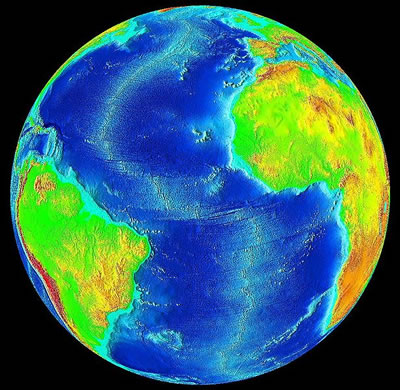It is the Earth's youngest ocean.
The Atlantic is continually increasing in size, as the continental plates continue to move apart. The floor of the Atlantic Ocean is spreading at the rate of about one inch (2.5 centimeters) every year.
 At the same time, the Pacific Ocean is becoming smaller.
At the same time, the Pacific Ocean is becoming smaller.
The Mid-Atlantic Ridge, the longest mountain range on Earth, is the Atlantic Ocean's most noticeable feature.
It runs along the center of the Atlantic, from north to south.
Most of the mountains of the Mid-Atlantic Ridge are completely underwater.
However, some mountain peaks appear above the water, as volcanic islands.
These include Iceland and the Azores.
A large rift valley lies at the center of the Mid-Atlantic Ridge. This rift valley is 15 to 30 miles (24 to 48 kilometers wide.)
The Mid-Atlantic Ridge divides the Atlantic into two troughs that run parallel to one another.
Local transform faults - faults where tectonic plates slide past each other - create ridges and valleys that run in an east-west direction and divide the two major troughs into many smaller basins. Some of these transform faults are 1,250 miles (2,000 kilometers) long.
The Gulf Stream, a current of warm water, runs across the east coast of America and then across the North Atlantic. As it moves northeast across the North Atlantic, it is known as the North Atlantic Drift. Winds from the west help to drive the Gulf Stream.
The Atlantic Ocean has large reserves of oil and natural gas.
Caribbean Sea
About three million years ago, continental drift closed up the Isthmus of Panama, resulting in the formation of the Caribbean Sea near Central America.
The Caribbean Sea contains an arc of volcanic islands.
Mediterranean Sea
The Mediterranean Sea separates Africa from Europe. The strait of Gibraltar connects the Mediterranean with the Atlantic Ocean.
It is believed that the region that is now the Mediterranean was once mostly deserting, about 10,000 feet (3,000 meters) below what is now sea level. This desert was covered with salt.
About 5 ½ million years ago, a ridge of land between Europe and Africa collapsed as the ocean floor subsided. This caused water to rush in, flooding the area.